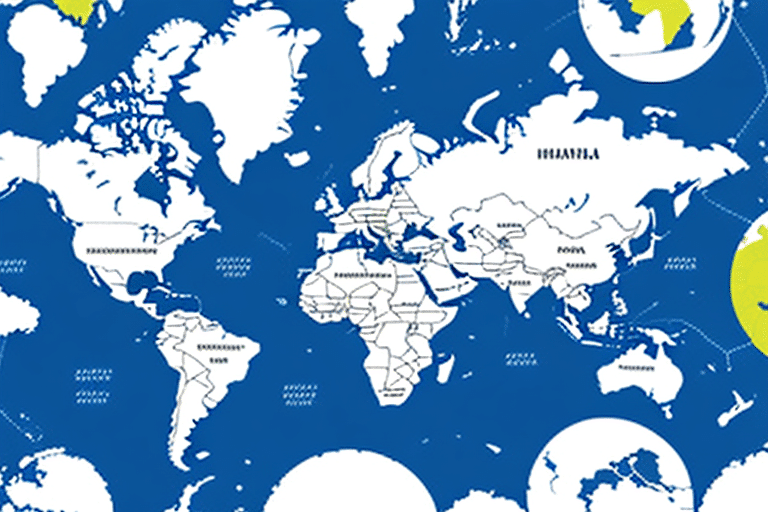Exploring E-Commerce International Shipping Solutions for Your Business
In today's global economy, e-commerce businesses must consider international shipping when looking to expand their customer base. Selling products internationally offers various benefits, such as increased sales revenue, broader customer reach, and diversification of business operations. However, international shipping also presents unique challenges that a business must overcome to succeed. This article will explore the different types of international shipping solutions available, factors to consider when choosing a provider, customs regulations and tariffs, packaging and labeling best practices, and tips for streamlining the international shipping process.
Why International Shipping is Crucial for E-Commerce Businesses
E-commerce businesses that sell internationally have significant advantages in terms of increasing their market reach and sales revenue. It allows businesses to transcend the geographical boundaries that limit conventional brick-and-mortar stores. With the use of the internet, businesses can connect with potential customers worldwide and offer them a seamless online shopping experience. International shipping also helps businesses engage with new audiences, create brand awareness, and establish credibility as a global enterprise.
Moreover, international shipping enables e-commerce businesses to tap into new markets and diversify their customer base. By expanding their reach beyond their domestic market, businesses can reduce their dependence on a single market and mitigate the risks associated with economic downturns or changes in consumer behavior. This diversification supports a stable revenue stream and sustains growth in the long run.
Additionally, international shipping can provide e-commerce businesses with a competitive edge over their domestic counterparts. By offering international shipping, businesses can differentiate themselves from competitors and attract customers seeking a wider range of products or services. This differentiation can help businesses increase their market share and establish themselves as leaders in their industry.
Types of International Shipping Solutions
There are numerous international shipping solutions available for e-commerce businesses. The most popular types include air freight, sea freight, express delivery, and postal services. Each option has unique advantages and disadvantages that must be considered before making a decision.
Air Freight
Air freight is the fastest shipping option, ideal for time-sensitive shipments. It offers quick delivery times, typically ranging from 1 to 5 business days. Air freight is suitable for high-value or perishable items but tends to be more expensive compared to other methods.
Sea Freight
Sea freight is a cost-effective solution for large or bulky shipments. While it offers lower costs, delivery times are longer, usually taking from 2 to 6 weeks depending on the destination. Sea freight is ideal for bulk goods, raw materials, and non-urgent shipments.
Express Delivery
Express delivery services, such as those offered by FedEx, UPS, and DHL, provide fast and reliable shipping with comprehensive tracking features. These services typically deliver within 3 to 7 business days and are suitable for businesses that prioritize speed and customer satisfaction.
Postal Services
Postal services are a viable option for smaller, less urgent shipments. They are generally more affordable but offer slower delivery times and less comprehensive tracking. Postal services are best suited for lightweight packages and businesses with budget-conscious shipping needs.
It's important to note that some international shipping solutions may have restrictions on certain types of products. For example, some countries have strict regulations on importing goods such as food or electronics. Researching and understanding these restrictions is crucial to avoid potential issues or delays in delivery. Additionally, some shipping solutions offer additional services like customs clearance or insurance, providing added protection and peace of mind for both the business and the customer.
Factors to Consider When Choosing an International Shipping Solution
Several factors must be considered before selecting an international shipping solution:
- Nature of the Product: Items requiring temperature control may necessitate air freight, while bulk shipments may be better suited for sea freight.
- Destination Country: Import restrictions and customs regulations vary by country and affect shipping choices.
- Delivery Time: Balancing delivery speed with cost impacts customer satisfaction and operational efficiency.
- Cost: Evaluating shipping rates, duties, taxes, and handling fees to maintain profitability.
- Tracking and Visibility: Ensuring real-time tracking to monitor shipments and manage customer expectations.
- Customer Support: Reliable support is essential for resolving issues related to customs clearance, delivery delays, and other concerns.
Understanding Customs Regulations and Tariffs
Customs regulations and tariffs are critical components of international shipping. These regulations vary by country, making it essential for businesses to stay informed about the latest changes to avoid legal issues. Understanding the applicable taxes and duties for different products is crucial. For instance, items like alcohol or tobacco may be subject to higher taxes or even prohibited in certain countries.
Proper documentation is vital for customs clearance. Essential documents include:
- Commercial Invoices
- Packing Lists
- Certificates of Origin
Accurate and complete documentation prevents delays and additional fees. Additionally, businesses must be aware of any trade agreements or sanctions that may affect their shipments. For example, certain trade agreements can offer preferential treatment, reducing tariffs and facilitating smoother shipping processes.
For more detailed information on customs regulations, refer to resources like the World Trade Organization (WTO) and the International Trade Administration (ITA).
Calculating the Cost of International Shipping
The cost of international shipping depends on multiple factors, including weight, distance, delivery time, and the chosen shipping solution. To accurately calculate shipping costs, businesses should consider:
- Shipping Method: Air freight is more expensive than sea freight but offers faster delivery.
- Destination: Shipping to remote or less accessible regions may incur higher costs.
- Custom Duties and Taxes: These vary by country and product type.
- Handling Fees: Additional services like packaging, insurance, and customs clearance add to the total cost.
Outsourcing shipping needs to third-party logistics providers or freight forwarders can streamline the process and potentially reduce costs. These providers handle various aspects of shipping, including documentation, customs clearance, and transportation management.
Packaging and Labeling Best Practices
Proper packaging and labeling are essential for the success of international shipments. Effective packaging protects products from damage during transit and ensures compliance with destination country regulations.
Packaging Materials
Use sturdy materials such as corrugated boxes, cushioning inserts, and moisture-resistant packaging to safeguard products. For fragile items, consider double-boxing or using specialized protective materials.
Labeling Requirements
Labels should include:
- Product Name
- Weight and Dimensions
- Country of Origin
- Handling Instructions
- Destination Address
Accurate labeling ensures that packages are processed correctly by customs and delivered to the right address without delays. Some countries have specific labeling requirements, so it's crucial to research and adhere to these guidelines.
Top International Shipping Providers for E-Commerce Businesses
Choosing the right international shipping provider is essential for the successful delivery of products to customers worldwide. Popular international shipping providers include:
When selecting an international shipping provider, consider factors such as shipping rates, delivery times, and tracking capabilities. Some providers may offer lower rates but longer delivery times, while others may provide faster delivery options at a higher cost.
Additionally, evaluate the provider's tracking systems to ensure both the business and customers can monitor shipment progress in real-time. Reliable tracking enhances transparency and improves the overall customer experience.
Streamlining Your International Shipping Process
Businesses can streamline their international shipping process by implementing best practices and leveraging available technology. Consider the following strategies:
- Automate Order Management: Use e-commerce platforms that integrate seamlessly with shipping providers to automate order processing and fulfillment.
- Generate Shipping Labels Automatically: Implement systems that automatically generate and print shipping labels, reducing manual effort and errors.
- Utilize Tracking and Notifications: Provide customers with real-time tracking information and automated delivery notifications to enhance transparency.
- Optimize Packaging: Use packaging materials that comply with destination regulations and protect products during transit.
- Maintain Accurate Documentation: Ensure all necessary customs documentation is complete and accurate to prevent delays.
Adopting these practices can significantly improve efficiency, reduce errors, and enhance the overall shipping experience for both the business and its customers.
Enhancing Customer Satisfaction with International Shipping
Customer satisfaction is paramount for e-commerce success. To improve the customer experience related to international shipping:
- Provide Accurate Delivery Estimates: Offer realistic delivery timelines to set proper customer expectations.
- Offer Multiple Shipping Options: Allow customers to choose between various shipping methods based on their preferences for speed and cost.
- Implement Transparent Tracking: Ensure customers can easily track their orders and receive timely updates on shipment status.
- Communicate Effectively: Maintain clear and proactive communication regarding order status, potential delays, and any issues that arise.
- Offer Delivery Incentives: Consider providing discounts or free shipping incentives for first-time international customers to encourage repeat business.
Implementing these strategies can lead to increased customer loyalty, positive reviews, and higher rates of repeat purchases.
Common Challenges in International Shipping and How to Overcome Them
International shipping presents several challenges for e-commerce businesses, including:
- Currency Exchange Rates: Fluctuations can impact pricing and profitability. Use dynamic pricing strategies to account for these changes.
- Language Barriers: Provide multilingual support and translate key information to cater to diverse customer bases.
- Cultural Differences: Understand and respect cultural norms and preferences to enhance customer relations.
- Regulatory Compliance: Stay informed about changing customs regulations and ensure compliance to avoid legal issues.
- Shipping Delays: Partner with reliable shipping providers and maintain transparent communication with customers to manage expectations.
By proactively addressing these challenges, businesses can navigate international markets more effectively and sustain growth.
Future Trends in E-Commerce and International Shipping
E-commerce and international shipping are continually evolving with advancements in technology and changes in consumer behavior. Key future trends include:
- Blockchain Technology: Enhances transparency, security, and efficiency in the shipping process by providing immutable records and streamlined documentation.
- Same-Day Delivery: Increasing demand for instant gratification is pushing providers to offer same-day or next-day delivery options.
- Smart Packaging Solutions: Incorporating IoT devices and smart materials to monitor conditions and provide real-time data during transit.
- Green Shipping Practices: Growing environmental concerns are driving businesses to adopt sustainable packaging and carbon-neutral shipping options.
- Automation and AI: Leveraging artificial intelligence to optimize routing, inventory management, and customer service interactions.
Staying abreast of these trends allows businesses to adapt and innovate, ensuring they remain competitive in the dynamic e-commerce landscape.
Conclusion
International shipping presents enormous opportunities for e-commerce businesses. By understanding the various types of international shipping solutions available, considering critical factors when choosing a provider, complying with customs regulations, ensuring proper packaging and labeling, streamlining the shipping process, managing customer satisfaction, and effectively tracking shipments, businesses can overcome challenges and succeed in international markets. Embracing emerging technologies and adapting to new trends will be crucial for maintaining competitiveness and achieving sustained success in the global e-commerce arena.






















